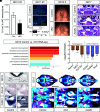Disruption of DNA methylation-mediated cranial neural crest proliferation and differentiation causes orofacial clefts in mice
- PMID: 38194455
- PMCID: PMC10801837
- DOI: 10.1073/pnas.2317668121
Disruption of DNA methylation-mediated cranial neural crest proliferation and differentiation causes orofacial clefts in mice
Abstract
Orofacial clefts of the lip and palate are widely recognized to result from complex gene-environment interactions, but inadequate understanding of environmental risk factors has stymied development of prevention strategies. We interrogated the role of DNA methylation, an environmentally malleable epigenetic mechanism, in orofacial development. Expression of the key DNA methyltransferase enzyme DNMT1 was detected throughout palate morphogenesis in the epithelium and underlying cranial neural crest cell (cNCC) mesenchyme, a highly proliferative multipotent stem cell population that forms orofacial connective tissue. Genetic and pharmacologic manipulations of DNMT activity were then applied to define the tissue- and timing-dependent requirement of DNA methylation in orofacial development. cNCC-specific Dnmt1 inactivation targeting initial palate outgrowth resulted in OFCs, while later targeting during palatal shelf elevation and elongation did not. Conditional Dnmt1 deletion reduced cNCC proliferation and subsequent differentiation trajectory, resulting in attenuated outgrowth of the palatal shelves and altered development of cNCC-derived skeletal elements. Finally, we found that the cellular mechanisms of cleft pathogenesis observed in vivo can be recapitulated by pharmacologically reducing DNA methylation in multipotent cNCCs cultured in vitro. These findings demonstrate that DNA methylation is a crucial epigenetic regulator of cNCC biology, define a critical period of development in which its disruption directly causes OFCs, and provide opportunities to identify environmental influences that contribute to OFC risk.
Keywords: birth defects; epigenetics; neural crest; orofacial morphogenesis.
Conflict of interest statement
Competing interests statement:The authors declare no competing interest.
Figures





References
-
- Semb G., Brattström V., Mølsted K., Prahl-Andersen B., Shaw W. C., The Eurocleft study: Intercenter study of treatment outcome in patients with complete cleft lip and palate. Part 1: Introduction and treatment experience. Cleft Palate Craniofac J. 42, 64–68 (2005). - PubMed
MeSH terms
Substances
Supplementary concepts
Grants and funding
LinkOut - more resources
Full Text Sources
Medical
Molecular Biology Databases

